Measuring the Success of Scotland's National Food and and Drink Policy. Food and Drink Indicators. Update on Progress, November 2012.
This paper provides updated data for the Food and Drink Technical Indicators used to measure the success of Scotland's National Food and Drink Policy.
Annex 2: Charts for Supporting Indicators
Supporting Indicator 10 - Food and Drink Labour Productivity
Labour Productivity of Food and Drink Manufacturing (GVA per employee)
Source: Office for National Statistics, Annual Business Survey (Complied by the Scottish Government)
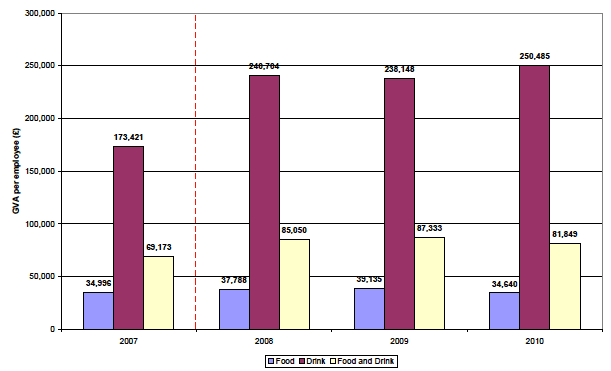
Between 2008 and 2010[20]:
- Labour productivity of Scottish food and drink manufacturing overall decreased by 3.8%.
- The overall decrease is due to a fall in labour productivity in food manufacturing, where productivity has decreased by 8.3% over the period.
- Labour productivity in drinks manufacturing increased by 4.1%.
Supporting Indicator 11 - Food and Drink Manufacturing Businesses by Size
Food and Drink Manufacturing Enterprises based in Scotland by size
Source: Scottish Government, ONS (IDBR)
Notes:
Graph scale is in percent but numbers have also been added as labels for additional information. The numbers of enterprises are rounded to the nearest 5. Totals may not equal the sum of the constituent parts due to rounding. The figures shown at the top of each bar are the total for all sizes of enterprises. Data for 2007 are based on SIC 2003 and data from 2008 onwards are on a SIC 2007 basis.
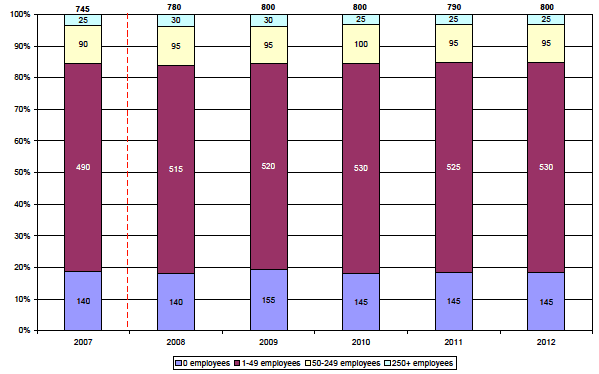
Between 2008[21] and 2012:
- The number of food and drink manufacturing companies registered in Scotland has remained mainly unchanged over the period. There were 800 registered enterprises based Scotland in 2012, 20 more than in 2008.
- Between 2011 and 2012, the number of food and drink manufacturing enterprises based in Scotland increased from 790 to 800.
- The size structure of food and drink manufacturing enterprises registered in Scotland has remained mainly unchanged over the period. The percentage of companies with zero employees remained at around 18%. The percentage of small companies (1 to 49 employees) represented about 66% of enterprises in 2008 and in 2012. The percentage of medium size companies (50 to 249 employees) was static over the same period at 12% while the percentage of large companies (250+ employees) remained around 3-4% over the period.
Supporting Indicator 12 - Research and Development Spend as a Proportion of Food and Drink Manufacturing Gross Value Added
Food and Drink Manufacturing R&D spend as a % of Food and Drink Manufacturing GVA
Source: Business Enterprise Research and Development Scotland 2010, Scottish Government; SABS, Scottish Government
| £m | 2007 | 2008 | 2009 | 2010 |
|---|---|---|---|---|
| Total spending on R&D in food and drink manufacturing[22] | 7.7 | 7.0 | 9.9 | 9.9 |
| Total spending on R&D in manufacturing | 447 | 412 | 445 | 415 |
| Total spending on R&D | 543 | 554 | 630 | 622 |
| R&D spend as a proportion of food and drink manufacturing GVA[23] | 0.24% | 0.19% | 0.26% | 0.28% |
Changes:
- R&D spend as a percentage of food and drink manufacturing GVA increased from 0.19%[24] of food and drink manufacturing GVA in 2008 to 0.28% of GVA in 2010.
- Total spending on R&D by the food and drink manufacturing sector increased from £7.0 million in 2008 to £9.9 million in 2010.
Supporting Indicator 13 - Food and Drink Spend by UK Tourists
UK Tourist Spend on Eating and Drinking in Scotland and Number of Visits
Source: Tourism in Scotland, Visit Scotland
Note: Data for 2011 relates to GB tourists only.
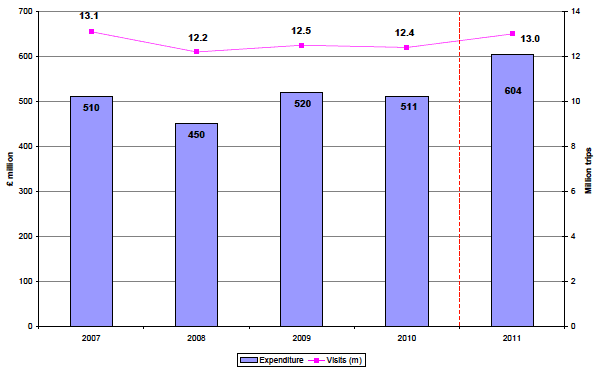
Changes:
- The number of UK tourist visits to Scotland fell from 13.1 million in 2007 to 12.4 million in 2010[25].
- Visits by GB tourists in 2011 amounted to 13 million trips.
- GB tourist expenditure on food and drink in Scotland was £604 million in 2011. This is almost £100 million higher than spending by UK tourists in 2007.
Supporting Indicator 14 - Expenditure on Food and Non-alcoholic Drinks as a Percentage of Household Expenditure by Income Decile
Household expenditure on food and non-alcoholic drinks, 2007-2010
Source: Expenditure and Food Survey, ONS
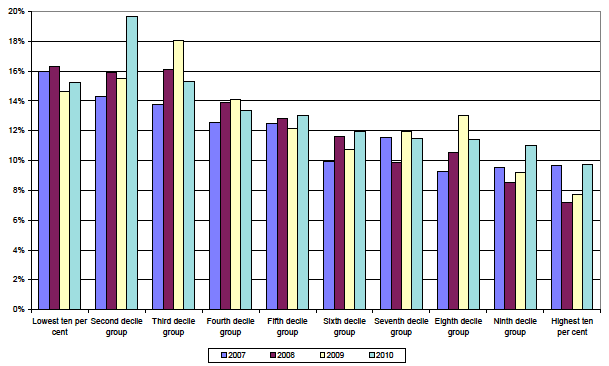
Changes:
- In 2010, the second income decile spent the largest percentage of their total expenditure on food and non-alcoholic drinks (19.7%) while in 2007, the lowest income decile spent the largest percentage of their total expenditure on food and non-alcoholic drinks (16.0%).
- In 2010 the 10% of total households earning the highest incomes spent the lowest percentage of their total expenditure on food and non-alcoholic drinks (9.7%). However, in 2007, it was the eighth income decile which spent the lowest percentage on food and non-alcoholic drinks (9.3%).
- The highest increase in expenditure was experienced by the 2nd income decile where expenditure on food and non-alcoholic drinks as a percentage of household expenditure increased by 5.4 percentage points, from 14.3% to 19.7% between 2007 and 2010.
- The largest decline in expenditure on food and non-alcoholic drinks as a percentage of household expenditure was experienced by the lowest income decile from 16.0% to 15.2%.
- Over the period 2007 to 2010 the proportion of expenditure spent on food and non-alcoholic drinks by all household as a percentage of total spending increased by 0.9 percentage points.
Supporting Indicator 15 - Agricultural Produce for Human Consumption per Capita
Agriculture production for human consumption per capita, UK and Scotland, 2007-2010
Sources: Economic Report on Scottish Agriculture, RESAS, DEFRA, GROS, ONS
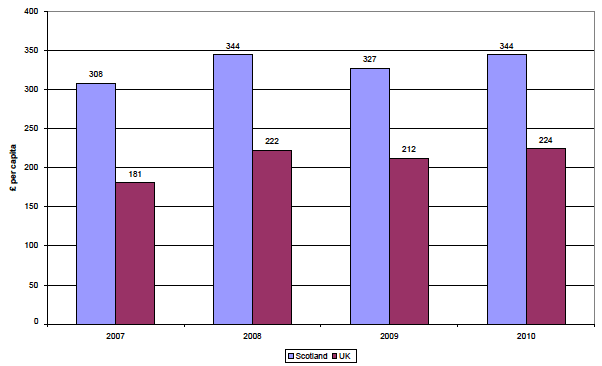
Changes:
- Agriculture production for human consumption per capita increased by 11.7% between 2007 and 2010 in Scotland. This compares to an increase of 24.1% for the UK over the same period.
- Between 2009 and 2010, agriculture production for human consumption per capita increased by 5.4% for Scotland. The increase was marginally higher in the UK at 5.7%.
Supporting Indicator 16 - Food and Packaging Waste
Waste produced by reporting Food and Drink Federation member sites in Scotland, 2006, 2008 and 2009
Source: Mapping Waste in the Food Industry, Defra, FDF
Note: Totals shown at top of bar
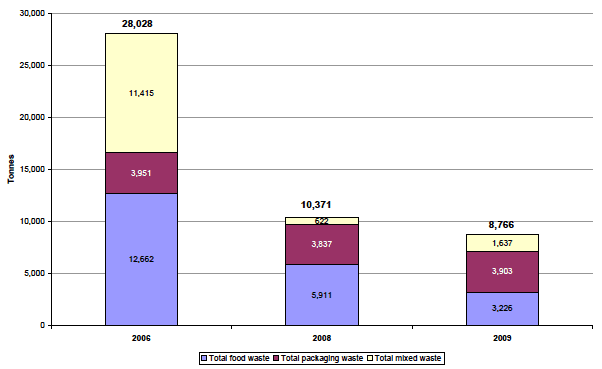
Between 2006 and 2009:
- Food and packaging waste fell by almost 70% from 28,028 tonnes to 8,766 tonnes. This was driven by a fall in food waste from 12,662 tonnes in 2006 to 3,226 tonnes in 2009. Mixed waste also fell from 11,415 tonnes in 2006 to 1,637 tonnes in 2009, a fall of 86%.
- In 2009, packaging waste made up the largest share of waste in the food and drink industry accounting for 45% of all food and drink waste. This was followed by food waste which accounted for 37% of total food and drink industry waste whilst mixed waste accounted for the smallest share at 19%.
Supporting Indicator 17 - Greenhouse Gas Emissions from Food and Drink Manufacturing
GHG emissions from Scottish food and drink processing, 2007-2010
Source: GHG Inventories for England, Scotland, Wales and Northern Ireland: 1990-2010, NAEI
Note: data includes tobacco processing
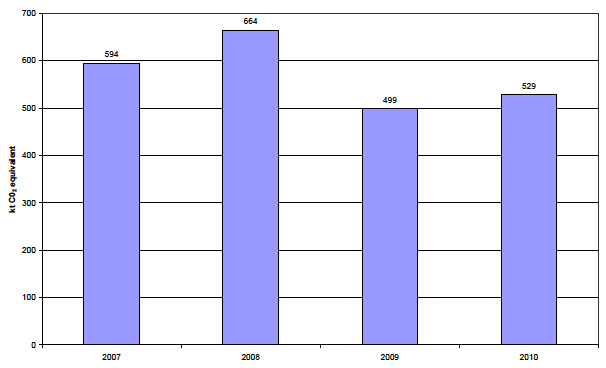
Changes:
- GHG emissions, by source, from food, drink and tobacco processing in Scotland decreased by 11% between 2007 and 2010, falling from 594 kt of CO2 equivalent in 2007 to 529 kt CO2 equivalent in 2010.
- GHG emissions were highest in 2008 at 664 kt CO2 equivalent.
Please note that this indicator now uses data from National Atmospheric Emissions Inventory (NAEI). Previously data for the indicator was based on experimental statistics for Scotland, these have not been updated and there are no plans to update these in the future. The emissions are source based emissions only. Thus they do not account for emissions resulting from the generation of electricity that is used on site. They also do not include emissions resulting from the transport of food and drink.
Supporting Indicator 18 - Eco-Schools Scotland Food and Environment Topic
Registered Local Authority Eco-schools
Source: Eco-Schools Scotland
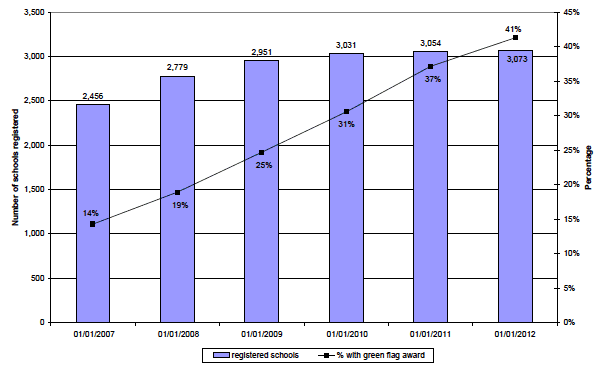
Between 2007 and 2012:
- As of 1 January 2012, there were 3,073 local authority schools registered in the scheme.
- Between January 2007 and January 2012 there was an increase in the proportion of local authority schools with green flag awards, from 14 per cent to 41 per cent.
- Data on participation in the Food and Environment topic is not yet available from the Eco-schools database. However, response to a postal survey sent out to schools found that in 2011 8.6% of registered schools were learning and teaching about food issues and in 2012 this increased to 19.5% of registered schools[26]. This represents an increase of 130 schools over the year.
Please note, the food and environment topic is not compulsory and was made available in March 2011.
Contact
Email: Caroline Gregory
There is a problem
Thanks for your feedback